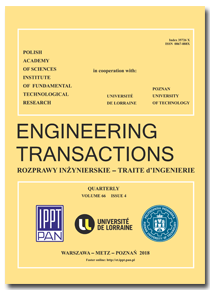10.24423/ENGTRANS.197.2008
Changes of the yield condition due to accumulation of damage of metal alloys
References
A. Wöhler, Versuche über die Festigkeit der Eisenbahnwagenachsen, Zeitschrift für Bauwesen, 1860.
A. Palmgren, Die Lebensdauer von Kugellagern, Verfahrenstechnik, Berlin, 68, 339–341, 1924.
M.A. Miner, Cumulative damage in fatigue, Journal of Applied Mechanics, 67, A159–A164, 1945.
B.F. Langer, Fatigue failure from stress cycles of varying amplitude, ASME Journal of Applied Mechanics, 59, A160–A167, 1937.
S.M. Marco, W.L. Starkey, A concept of fatigue damage, Trans. of ASME, 76, 627–632, 1954.
L. Yang, A. Fatemi, Cumulative Fatigue Damage Mechanisms and Quqntifying Parameters: A Literature Review, J. of Testing and Evaluation, 26, 2, 89–100, 1998.
L.M. Kachanov, Introduction to Continuum Damage Mechanics, Martinus Nijhoff, The Netherlands, 1986.
S. Murakami, Progress of continuum damage mechanics, JSME Int. J., 30, 701–10, 1987.
G. Socha, Prediction of the Fatigue Life on the Basis of Damage Progress Rate Curves, Int. Journal of Fatigue, 26, 4, 339–347, 2004.
G. Socha, Experimental investigations of fatigue cracks nucleation, growth and coalescence in structural steel, Int. Journal of Fatigue, 25, 2, 139–147, 2003.
G. Socha, Influence of Recovery on Plastic Anisotropy of Metals, Engrg. Trans., 45, 2, 181–189, 1997.
W. Prager, The theory of plasticity: a survey of recent achievements, Proc. Inst. Mech. Engrs., 169, 41, 1955.
H. Ziegler, A modification of Prager’s hardening rule, Quarterly of Applied Mathematics, 17, 1, 1959.
W. Szczepiński, On deformation-induced plastic anisotropy of sheet metals, Arch. Mech., 45, 1, 3–38, 1993.
A. Menzel, M. Ekh, K. Runesson and P. Steinmann, A framework for multiplicative elastoplasticity with kinematic hardening coupled to anisotropic damage, Int. Journ. of Plasticity, 21, 3, 397–434, 2005.
G. Johansson, M. Ekh and K. Runesson, Computational modeling of inelastic large ratcheting strains, Int. Journ. of Plasticity, 21, 5, 955–980, 2005.
M. Brünig and S. Ricci, Nonlocal continuum theory of anisotropically damaged metals, Int. Journ. of Plasticity, 21, 7, 1346–1382, 2005.
De-Guang Shang, Wei-Xing Yao, A nonlinear damage cumulative model for uniaxial fatigue, Int. J. Fatigue, 21, 187–194, 1999.
N. Bonora, D. Gentile, A. Pirondi and G. Newaz, Ductile damage evolution under triaxial state of stress: theory and experiments, Int. Journ. of Plasticity, 21, 5, 955–980, 2005.
A. Pirondi, N. Bonora, D. Steglich, W. Brocks and D. Hellmann, Simulation of failure under cyclic plastic loading by damage models, Int. Journ. of Plasticity, 22, 11, 2146–2170, 2006.
V. Moorthy, B.K. Choudhary, S. Vaidyanathan, T. Jayakumar, K. Bhanu Sankara Rao, Bladev Raj, An assessment of low cycle fatigue damage using magnetic Barkhausen emission in 9Cr-1Mo ferritic steel, Int. J. Fatigue, 21, 263–269, 1999.
G. La rosa, A. Risitano, Thermographic methodology for rapid determination of the fatigue limit of materials and mechanical components, Int. J. Fatigue, 22, 65–73, 2000.
N.G.H. Meyendorf, H. Rosner, V. Kramb, S. Sathish, Thermo-acoustic fatigue characterization, Ultrasonics, 40, 427–434, 2002.
Y. Nakai, S. Fukuhara, K. Ohnisji, Observation of fatigue damage in structural steel by scanning atomic force microscopy, Int. J. Fatigue, 19, 1, S223–S236, 1997.
DOI: 10.24423/ENGTRANS.197.2008




